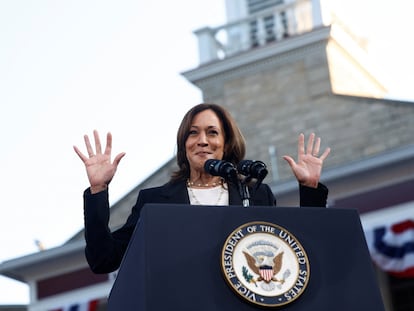Texas border: Hispanic voters shift to the right in southern districts
Races in the five border areas highlight the underlying currents that are changing voter sentiment, as immigration becomes a top concern

Texas’s 15th district — a narrow strip along the border near McAllen — has long been a Democratic stronghold. In its more than a century of history, it had never been represented by a Republican in Washington — until two years ago. In the 2022 midterms, political newcomer Monica de la Cruz won a surprise victory. In a district where 81% of the population is Latino, it seemed unlikely that the candidate would win, given her campaign echoed the most hardline and immigration-focused aspects of Trumpism, such as the promises to finish the wall and require asylum seekers to wait in Mexico. However, the result revealed the underlying currents shaping voter sentiment.
The district, which extends to the outskirts of San Antonio, is one of five that comprise the Texas-Mexico border. It includes a small, urban 16th district encompassing El Paso; a large and predominantly rural 23rd district that spans much of the border, and three additional districts running parallel in the southeast, which complete the lower edge of Texas’s congressional district map.
Despite the geographic differences among them, two constants remain: all five districts have a majority Latino population and a predominantly Democratic tradition. However, following De la Cruz’s victory in the last election, their status as blue bastions is wavering, and they appear to be turning purple.
Both parties are taking notice. While the 16th and 23rd districts are largely secure — El Paso firmly in Democratic hands and the surrounding vast territory, aligned with the state’s rural areas, leaning Republican in recent elections — the other three districts in that densely populated corner have become unlikely battlegrounds.
The Republican Party included the districts in its prediction of a red tide in the midterms, and while only De la Cruz emerged victorious, the party made significant gains across the board. Recently, the state party announced a substantial investment and mobilization effort in the region. In response, the Democrats have allocated additional funding to their candidate, Michelle Vallejo, who is once again challenging De la Cruz in the 15th district. This move is part of their initial rollout of the Red to Blue strategy, targeting constituencies they believe have the potential to flip.

Two years ago, Democrat Michelle Vallejo’s campaign aligned with the party’s progressive wing, earning her the explicit support of Bernie Sanders. Her platform focused on expanding Medicare, ensuring access to abortion, and strengthening social security. This year, those themes remain central to her messaging as she accuses De la Cruz of undermining them from Washington. However, an unexpected issue has emerged in her campaign: immigration. Just over a month ago, Vallejo released an ad promising to “secure the border” and hire thousands more border agents to address the “chaos,” stating that it’s “time to get serious.”
This marks a significant shift from her previous stance, where she condemned the “hyper-militarization” of the border as Trump pushed his border wall. Although Vallejo rejects the criticisms at the move and claims to support the party line — defending the bipartisan border security law that was abruptly struck down earlier this year at Donald Trump’s behest — this change indicates that the electorate has hardened its views and that the risk of losing votes is increasingly real.
In the district to the east, drawn up just a decade ago, a similar situation is unfolding: a showdown between the same candidates from the 2022 midterms. Here, Democrat Vicente Gonzalez is defending his seat against Republican Mayra Flores, who has been endorsed by former president Donald Trump. Flores’s campaign reflects key themes of the national Republican Party, focusing on tougher border security measures, an end to “indoctrination” in schools, and other culture war issues.
Gonzalez, like her party colleague Vallejo, has hardened her own rhetoric, especially on immigration, even though she has long supported increasing the number of border agents. As a member of the more moderate wing of the Democratic Party since entering politics, her positions this year may be less surprising; however, they indicate that the border votes the Democratic Party once took for granted are no longer assured.
In the third of these southeastern Texas districts — which includes the city of Laredo —, Democratic Rep. Henry Cuellar has won every election since 2002. Over the years, Gonzalez has also adjusted his stance on immigration. Despite recent and repeated corruption allegations against him, Republicans are not heavily campaigning in this area: the party tried this approach in the last election and lost by 13 points. As a major fundraiser with deep roots in the area, Cuellar remains a formidable candidate. While the accusations have damaged his credibility, they have not significantly undermined his position. Instead, Republicans are focusing their efforts on targeting Gonzalez, who has a much narrower lead.
The five border districts in South Texas illustrate the dynamics of the Latino electorate in 2024. In urban areas like El Paso, the electorate is decidedly progressive, while rural regions lean much less so. Two years ago, the Republican Party anticipated a red tide sweeping across large swaths of the United States. However, in South Texas, only Monica De la Cruz’s solitary wave managed to breach the blue walls. Today, the border is considered purple territory, equally winnable by either party.
Sign up for our weekly newsletter to get more English-language news coverage from EL PAÍS USA Edition
Tu suscripción se está usando en otro dispositivo
¿Quieres añadir otro usuario a tu suscripción?
Si continúas leyendo en este dispositivo, no se podrá leer en el otro.
FlechaTu suscripción se está usando en otro dispositivo y solo puedes acceder a EL PAÍS desde un dispositivo a la vez.
Si quieres compartir tu cuenta, cambia tu suscripción a la modalidad Premium, así podrás añadir otro usuario. Cada uno accederá con su propia cuenta de email, lo que os permitirá personalizar vuestra experiencia en EL PAÍS.
¿Tienes una suscripción de empresa? Accede aquí para contratar más cuentas.
En el caso de no saber quién está usando tu cuenta, te recomendamos cambiar tu contraseña aquí.
Si decides continuar compartiendo tu cuenta, este mensaje se mostrará en tu dispositivo y en el de la otra persona que está usando tu cuenta de forma indefinida, afectando a tu experiencia de lectura. Puedes consultar aquí los términos y condiciones de la suscripción digital.
More information
Archived In
Últimas noticias
Most viewed
- Reinhard Genzel, Nobel laureate in physics: ‘One-minute videos will never give you the truth’
- Oona Chaplin: ‘I told James Cameron that I was living in a treehouse and starting a permaculture project with a friend’
- Pablo Escobar’s hippos: A serious environmental problem, 40 years on
- Why we lost the habit of sleeping in two segments and how that changed our sense of time
- Charles Dubouloz, mountaineering star, retires at 36 with a farewell tour inspired by Walter Bonatti











































